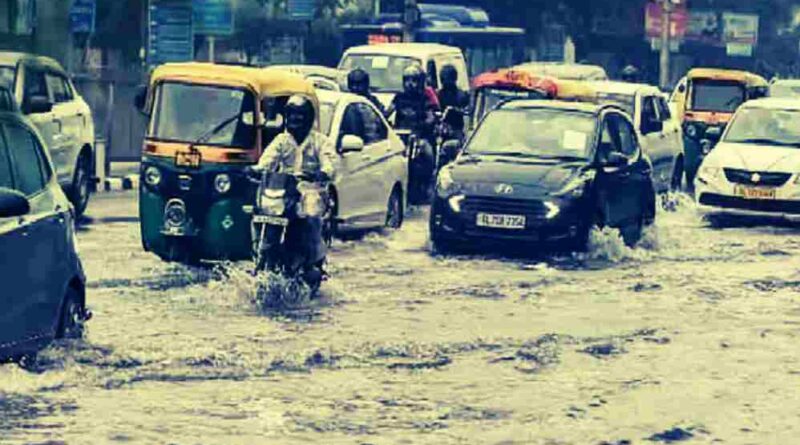Delhi Submerged: Torrential Rains Bring City to a Standstill
A Morning That Changed Everything
What began as a cloudy morning in Delhi quickly turned into chaos as heavy rain lashed the capital and surrounding NCR areas. The downpour was relentless—within hours, familiar streets were submerged, homes were flooded, and the city’s fragile drainage system was laid bare once again.
By mid-morning, the rhythm of daily life was shattered. Schools saw thin attendance, office-goers were stuck in endless traffic jams, and shopkeepers stood helplessly watching water creep into their businesses.
Roads or Rivers?
From busy commercial hubs to quiet residential colonies, the city’s roads looked less like transport routes and more like swollen streams. Stretches in areas such as Punjabi Bagh, Okhla, MB Road, and near the Tughlakabad underpass became completely waterlogged, trapping cars, buses, and motorbikes in long queues.
Public transport wasn’t spared either—buses struggled to navigate waist-deep water in some places, and autorickshaw drivers either refused passengers or charged inflated fares to brave the flooded routes.
Life Inside the Colonies
Inside Delhi’s residential colonies, scenes were equally grim. Narrow lanes turned into stagnant ponds, forcing residents to wade through knee-deep water just to buy groceries or reach main roads. In some low-lying pockets, water entered homes, soaking furniture, appliances, and food supplies.
In one striking moment, residents of a South Delhi neighborhood watched as a man rowed a makeshift boat down their street—turning a disaster into an oddly surreal scene that summed up the capital’s predicament.
Tragedy Strikes in the Rain
The storm wasn’t just an inconvenience—it was deadly. In the Kalakaji area, a motorcyclist lost his life after a large tree, its roots weakened by the rain, toppled onto him. The incident sparked outrage among locals, many of whom blamed poor maintenance of public spaces and lack of safety checks.
Elsewhere, walls weakened by the downpour crumbled, injuring passersby and damaging parked vehicles. These incidents triggered fresh debates on the accountability of civic authorities, with opposition leaders demanding resignations for what they called “avoidable tragedies.”
Rising Yamuna: A New Threat Looms
Adding to the city’s woes, the Yamuna River swelled to 204.43 meters—just 7 centimeters below the official warning mark. Authorities monitored the situation closely, fearing that continued rainfall could trigger flooding in vulnerable riverside areas. Residents living near the banks began moving valuables to higher ground as a precaution.
The Familiar Monsoon Problem
This year’s flooding is no anomaly—it’s a repeating story that Delhiites have grown tired of telling. Every monsoon exposes the same flaws: insufficient desilting of drains, outdated infrastructure, and delayed emergency responses. Civic bodies promise improvements every year, but by the time the next heavy rain hits, the promises seem to wash away.
Many residents voiced their frustration, saying that for a city of Delhi’s stature, “swimming to work in 2025” shouldn’t still be a reality.
More Rain on the Horizon
The weather department forecasts more showers over the next two days, with the possibility of heavy bursts in certain parts of the city. Authorities have urged citizens to avoid unnecessary travel, keep emergency numbers handy, and monitor updates on water levels.
For now, Delhi is left drenched, disrupted, and demanding answers—its streets telling a story of resilience, frustration, and a city still learning to live with the monsoon.
Disclaimer
The information and content shared on digitalgithub.com — including articles, blogs, news, guides, and other resources — is intended for general informational and educational purposes only. We do not guarantee the completeness, reliability, or suitability of any information. Always seek the guidance of a qualified professional before making decisions based on the information you read. Use this site at your own risk.

